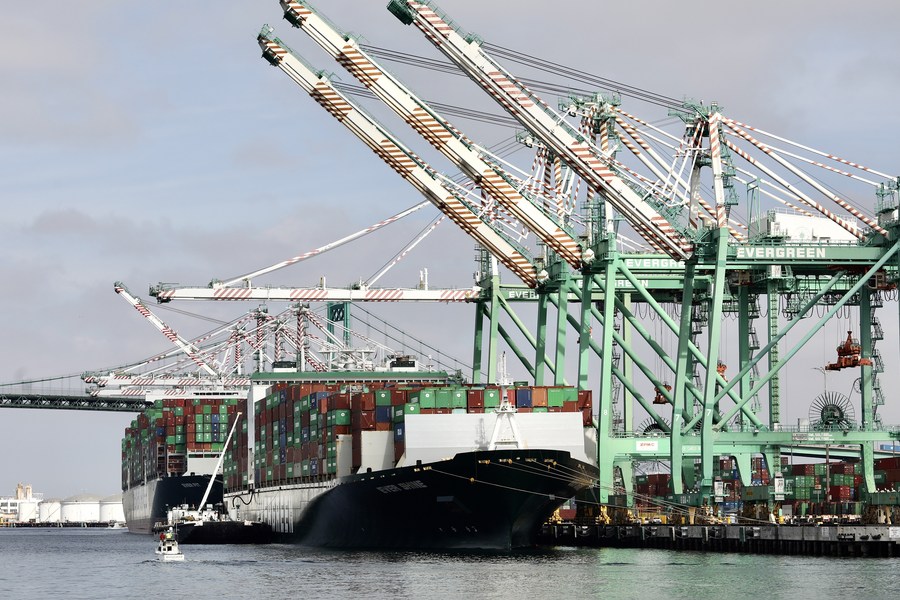Most U.S. congressional districts see growth in goods exports to China in 2020: USCBC

Container ships are seen at the port of Los Angeles, California, the United States, on Oct. 22, 2021. (Xinhua)
U.S. goods exports to China grew by roughly 18 percent to 123 billion U.S. dollars in 2020, marking a sizable rally from a near-decade low in 2019, while U.S. goods exports to the rest of the world fell by 15 percent, a report said.
WASHINGTON, Nov. 1 (Xinhua) -- Most U.S. congressional districts exported more goods to China in 2020 compared to the previous year despite bilateral tensions and the beginning of a pandemic-induced global recession, according to a report released Monday by the U.S.-China Business Council (USCBC).
U.S. goods exports to China grew by roughly 18 percent to 123 billion U.S. dollars in 2020, marking a sizable rally from a near-decade low in 2019, while U.S. goods exports to the rest of the world fell by 15 percent, the report said.
"This disparity is likely the result of China outpacing the rest of the world in its recovery from the pandemic-induced slowdown," the report said, noting the top U.S. goods exports to China are oilseeds and grains, semiconductors and their componentry, oil and gas, and motor vehicles.
A total of 278 out of 435 U.S. congressional districts saw growth in goods exports to China in 2020, and 72 districts increased their exports by more than 100 million dollars, according to the report.
The increase was particularly sharp in the farming communities of the Midwest, oil-exporting regions in Texas and Louisiana, and Oregon's semiconductor hub, also known as Silicon Forest, the report said, adding China remained the United States' third-largest goods export market.
"Our data show that tariff relief by China's government, which allowed Chinese buyers to purchase U.S. goods based on market demand after years of hampered trade, also helped fuel American goods exports in many parts of the country," USCBC President Craig Allen said in a statement.

A farm owner examines harvested corn on a combine harvester in a field of his family farm in Atlantic, in the Midwestern state of Iowa, the United States, Oct. 14, 2019. (Xinhua/Wang Ying)
"USCBC continues to advocate for both the United States and China to draw down and permanently remove all of their respective tariffs," Allen said.
U.S. services exports to China, the data for which lag a year behind, fell slightly to just over 54 billion dollars in 2019, partly due to declining numbers of Chinese travelers to the United States for business, pleasure and education, according to the report.
"The decline in travelers could have been the result of the trade war and other bilateral tensions, which might have made the United States an undesirable destination in the eyes of Chinese travelers," the report said.
However, of the United States' top 10 services export markets in 2019, China had the highest average annual growth rate over the previous decade.
Meanwhile, China was the United States' fourth-largest services export market, and many congressional districts, particularly those that represent large metropolitan areas, college towns, or logistics hubs, still generate substantial economic value from service exports to China.
"As our data show, trade between the United States and China has real consequences for businesses, workers, and communities all across the country and nearly every industry," Allen said.
Photos
Related Stories
- Study says U.S. "China Initiative" stymies scientific innovation: SCMP
- Scholar elaborates on marked contrast of changing living standards between China, U.S.
- China slams "declassified assessment on COVID-19 origins" released by U.S.
- Chinese FM urges U.S. to change its wrong China policy
- U.S. asking domestic telecom carriers to abandon Chinese suppliers a self-defeating mission
Copyright © 2021 People's Daily Online. All Rights Reserved.










